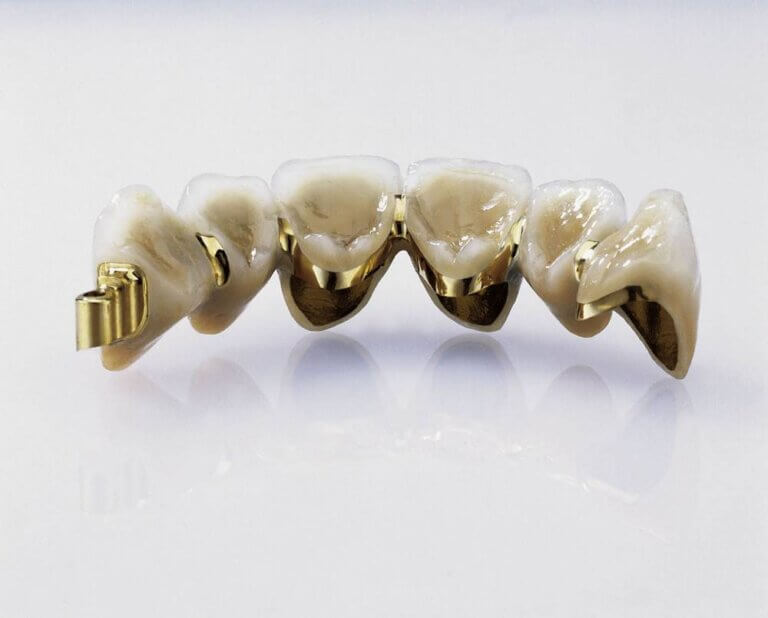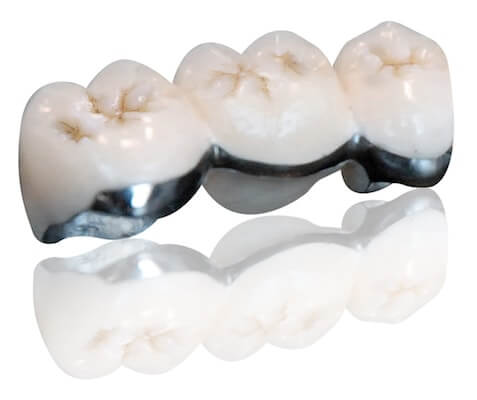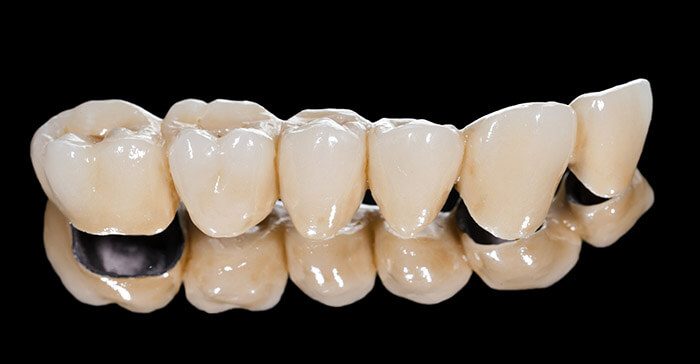Porcelain Fused To Metal Dental Bridge

What Is A Porcelain Fused To Metal Dental Bridge?
A Porcelain Fused to Metal Dental Bridge (PFM Bridge) is a fixed dental restoration designed to replace one or more missing teeth. It consists of:
- Metal Framework: Provides strength and durability.
- Porcelain Overlay: Mimics the natural color and translucency of teeth for a lifelike appearance.
PFM bridges are anchored to the adjacent natural teeth (abutments) or dental implants, with the artificial tooth (pontic) filling the gap. Combining the strength of metal with the aesthetics of porcelain, PFM dental bridges are a popular choice for restoring functionality and the beauty of your smile.
Before deciding on whether A Porcelain Fused To Metal Dental Bridge are right for you, there are some things you should know:
- Who Needs A Porcelain Fused To Metal Dental Bridge?
- Benefits Of A Porcelain Fused To Metal Dental Bridge
- Alternative Treatments To Porcelain Fused To Metal Dental Bridges
- How Much Does A Porcelain Fused To Metal Dental Bridge Cost?
- Steps In The Porcelain Fused To Metal Dental Bridge Procedure
- Frequently Asked Questions About Porcelain Fused to Metal Dental Bridges
If you have any further questions about A Porcelain Fused To Metal Dental Bridge or other dental services offered at Atlas Dental, please contact us.

Free phone consultation
Are you missing teeth and have questions about Dental Bridges? Schedule a free phone consultation with our GTA dentist.

5 star google reviews
Our patients love us! See why people are choosing Atlas Dental for Dental Bridges.

Book Emergency Bridge visit online
Have a problem with your Dental Bridge? Book An Emergency Dental Appointment Online.
Who Needs A Porcelain Fused To Metal Dental Bridge?
A PFM dental bridge may be ideal if you:
- Have Single or Multiple Missing Teeth: Whether you’re missing one tooth or several in a row, a PFM dental bridge can restore both function and aesthetics by filling the gap seamlessly.
- Are Unsuitable for Dental Implants: If dental implants are not an option for you due to insufficient bone density, health conditions, or financial considerations, a PFM dental bridge provides a reliable alternative.
- Experience Difficulty Chewing or Speaking: Missing teeth can make it challenging to eat or speak clearly. A PFM bridge can improve your ability to chew food comfortably and pronounce words correctly.
- Want to Prevent Dental Shifting: Missing teeth can cause neighboring teeth to shift into the gap, leading to misalignment and other dental issues. A PFM bridge maintains proper spacing and alignment.
- Seek a Cost-Effective and Aesthetic Option: With its combination of metal strength and porcelain’s natural look, a PFM dental bridge offers an attractive and durable solution that mimics the appearance of natural teeth.
Before proceeding, it’s essential to consult a dental professional to evaluate your oral health and determine whether a PFM dental bridge is the best option for your needs. If you have further questions about Porcelain Fused To Metal Dental Bridges, please contact us.
Benefits Of A Porcelain Fused To Metal Dental Bridge
A porcelain fused to metal (PFM) dental bridge has several advantages that contribute to its widespread use:
- Natural Appearance: The porcelain overlay closely matches the color and translucency of natural teeth, providing a seamless blend.
- Strength and Durability: The metal base ensures the bridge can withstand chewing forces, especially in molar areas.
- Cost-Effectiveness: PFM bridges offer a balance of affordability, durability, and aesthetics compared to alternative materials like zirconia.
- Stain Resistance: Porcelain resists stains, helping the bridge maintain its appearance over time.
- Longevity: With proper care, PFM bridges can last 10–15 years or longer.
Your dentist will evaluate your oral health, discuss your goals, and create a personalized treatment plan that aligns with your needs and preferences. If you have further questions about Porcelain Fused To Metal Dental Bridges, please contact us.

Alternative Treatments To A Porcelain Fused To Metal Dental Bridge
Here are alternative treatment options available if you decide that a PFM bridge isn’t the right choice for you:
- Maryland Bridge: Also known as a resin-bonded bridge, a Maryland bridge is a conservative option suitable for replacing a single missing tooth. It involves attaching a pontic (artificial tooth) to the adjacent teeth using a metal or porcelain framework.
- Cantilever Bridge: This type of bridge is used when there is only one adjacent tooth next to the gap. The pontic is supported by a crown on the adjacent tooth, creating a cantilever structure. Cantilever bridges are typically used in low-stress areas of the mouth.
- Zirconia Bridge: Zirconia bridges offer excellent strength and durability, similar to PFM bridges, but without the metal framework. They are known for their biocompatibility and natural appearance.
- Lithium Disilicate Bridge: These bridges are made from a high-strength ceramic material and are known for their aesthetics and durability. They are a popular choice for visible areas of the mouth.
- Gold Bridge: Gold bridges are known for their longevity and biocompatibility. They are often chosen for their functional benefits and are less commonly used for aesthetic reasons.
- Dental Implant: Dental implants involve surgically placing a titanium post into the jawbone and attaching a crown or bridge to replace a missing tooth. Implants offer a long-term solution with minimal impact on surrounding teeth.
- Removable Partial Dentures: If you’re seeking a removable option, partial dentures might be suitable. These dentures are custom-made to fit your mouth and can replace one or more missing teeth. They are held in place by clasps that attach to existing teeth.
Each alternative treatment comes with its own set of benefits and considerations. Factors such as cost, durability, aesthetics, and your overall oral health will influence which option is the best fit for you. If you have further questions about Porcelain Fused To Metal Dental Bridges, please contact us.
Cost of Dental Bridge
The price of a Dental Bridges will depend on the number of pontics and retainer. For example, a 3-unit bridge, for example, would cost $1234+550+1234 plus dental lab fee (approximately $600), which would equal $3618. The codes relevant to dental bridges in the Ontario Dental Association’s Suggested Fee Guide appear as follows:
Pontics, Porcelain/Ceramic/Polymer Glass
- 62501 – Pontics, Porcelain/Ceramic/Polymer Glass Fused to Metal: $550 + Dental Lab Fee
Retainers, Porcelain/Ceramic/Polymer Glass
- 67201 – Retainer, Porcelain/Ceramic/Polymer Glass: $1234 + Dental Lab Fee
Dental bridges are sometimes considered a supplementary service by dental insurance plans and may or may not be covered by your dental insurance. Be sure to find out from your dental insurance plan provider how much you are eligible for before going ahead with dental treatment. Your dentist can help you submit an predetermination to your dental insurance.
For patients without dental insurance, Atlas Dental is pleased to offer dental financing through iFinance Dentalcard. Affordable payment plans start at 7.95% for terms of 6 months to 6 years. To learn more about Dentalcard dental treatment financing, follow this link.
Steps In The Porcelain Fused To Metal Dental Bridge Procedure
Here’s an overview of the typical PFM Bridge procedure:
- Initial Consultation: Your dentist will assess your oral health, take X-rays, and discuss your options.
- Tooth Preparation: The abutment teeth are reshaped to accommodate the bridge.
- Impressions and Shade Matching: Accurate impressions are taken, and the shade is chosen to match your natural teeth.
- Temporary Bridge: A temporary bridge is placed to protect your teeth while the permanent one is crafted.
- Bridge Placement: Once ready, the permanent bridge is fitted and cemented. Adjustments ensure a comfortable bite.
By following these steps and collaborating closely with your dentist, you can expect to achieve a restored smile that enhances both your appearance and your overall quality of life. If you have further questions about Porcelain Fused To Metal Dental Bridges, please contact us.

Frequently Asked Questions About Porcelain Fused to Metal Dental Bridges
- How long does a PFM dental bridge last?
With proper care, a PFM bridge can last 10–15 years or more. Regular dental check-ups and good oral hygiene are essential for longevity.
- Can I get a PFM bridge during pregnancy?
Yes, but non-urgent dental procedures are typically delayed until after pregnancy unless medically necessary.
- Are PFM dental bridges noticeable?
No. The porcelain overlay ensures a natural look, blending seamlessly with your teeth.
- How do I care for my PFM dental bridge?
Brush twice daily, floss under the bridge with a floss threader, and visit your dentist regularly for cleanings and exams. Please read our dental bridge post-insertion instructions.
At Atlas Dental, we specialize in creating durable, aesthetically pleasing dental restorations like Porcelain Fused to Metal Dental Bridges. Contact us today to explore your options and take the first step toward a restored smile!

